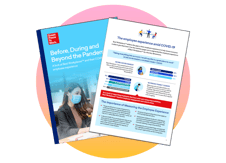When people choose not to reveal parts of their identity, they're telling you a lot. At Great Place to Work® UK, we believe no employee – whether within or outside of the LGBTQ+ community – should have to disguise themselves to “fit in” at work.
Every person deserves the freedom to show up as their true self. And when employees bury their identities, it speaks volumes about the level of psychological safety in your workplace.
On the surface, it may look like your workplace has created a positive employee experience for all. But without surveying your people, how will you know if this is true?
Identifying Disparities In Your Data
One of the things that businesses value about our employee survey is that it uncovers the “masked” workplace experiences for different employee groups within their organisation.
Part of this process involves asking several questions about employees’ personal characteristics to enable companies to identify disparities in the workplace experience based on various demographics.
Identifying these disparities is the first step in correcting them and creating a better, more equal experience for all employees. Some of these can be sensitive questions – like enquiring about a person’s sexual orientation or gender identity – so our survey gives people the option to decline to respond if they wish.
You might expect only a small percentage of employees choose this ‘prefer not to respond’ option, but it turns out that one in eight employees actively declines to reveal one or more aspects of their identity.
Why employees choose “prefer not to answer”
So what’s happening here? Why are over 12% of employees declining to share information about themselves? To get to the bottom of this issue, we reviewed written comments from employees who declined to respond to one or more of these survey questions.
Their comments often provided some clarity, or at least clues, around why these employees don’t want to reveal their whole selves. Common themes from these employees’ experiences include:
- A climate of favouritism
- Toxic work relationships
- Passive aggressiveness
- A lack of trust to speak up
- Fear of retaliation
Harassment may not define the kind of workplace environment those themes describe. But it’s easy to see them as “harassment adjacent” — rife with microaggressions and fear.

What these (non-)responses say about your company culture
When people choose not to reveal parts of their identity, they're actually telling you a lot about how they feel at work. One employee who left part of their identity hidden writes, “How can you trust a system/business that rewards its malicious employees...? It’s quite discouraging for those of us who are aware of the offense.”
Another comments: “I don’t have full trust in our HR department. I would not share confidential information with them because I do not feel it would stay confidential.”
There are clear ties between consistently inclusive workplace cultures and overall employee experience and engagement. If employees decline to reveal their full selves in surveys, it suggests your workplace may not be a psychologically safe environment for people of all gender identities and sexual orientations. As more people choose not to respond, trust and innovation suffer.
As the percentage of employees choosing ‘prefer not to respond’ grows, there are drops in:
- Employees’ faith in management
- Their sense of safety in the work environment
- Signs of teamwork
These are all critical to effective innovation and strong business results. A high rate of “prefer not to respond” answers in your employee survey data suggests that your business may not be positioned to thrive, particularly during economic downturns.
Choosing “prefer not to respond” is a signal of fear in the workplace, hurts belonging and lowers self-esteem and employee engagement.
By paying close attention to these (non-)responses, HR leaders can uncover insights to help tailor their D&I strategies; find undiscovered pockets of strength; and monitor people’s ability to bring their full selves to work.

Employee Experience: Impact of Covid-19 Report
Download your copy and see how Best Workplaces™ are tailoring their employee experience to fit a post-Covid world.
The feature has been adapted from a similar article by Claire Hastwell, Content Marketing Manager at Great Place to Work®. Claire works with our data and company culture experts to bring you the most useful insights and advice. When she’s not sifting through our 30+ years of employee survey data and identifying trends, she's rolling out her yoga mat or daydreaming about her next road trip.











